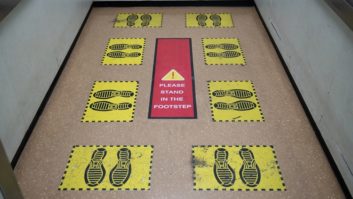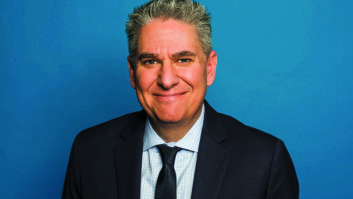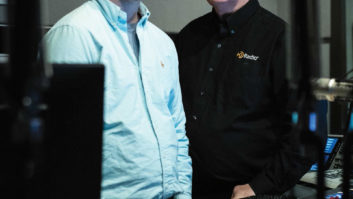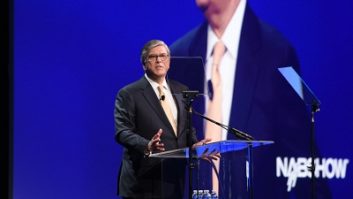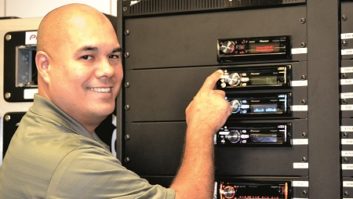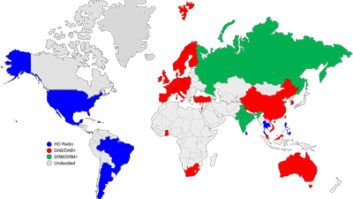Larry Magne Prepares to Publish His 20th Edition of ‘Passport’
The New York Times described the annual “Passport to World-Band Radio” as the TV Guide for world-band radios.
It’s an apt description. The 2003 edition contains 300 pages of station listings by hour, country and frequency. It includes receiver reviews and buying advice, recommended world-band programs, special features and the names, addresses, phone numbers and Web sites of world broadcasters.
The Times is not alone in praising “Passport.” On Amazon.com, every consumer who bought this book gave it five stars.
“Tells you everything you need to know,” wrote Ricky W. Cancilla.
“Must-have for shortwave radio,” stated Jolene Gerlach.
“Absolutely gotta have if you listen to shortwave,” concluded an anonymous reviewer.
Meanwhile, Radio Netherlands’ Media Network Web site enthuses that “‘Passport to World-Band Radio’ is the best all-round package for frequency information, programming listening advice and receiver test reports.” Given that Media Network is not usually given to such outbursts, this is high praise indeed.
The accidental consultant
Its publisher cites online sales rankings in asserting that “Passport” now outsells the venerable U.K.-based World Radio Television Handbook annual. Perhaps surprising, then, is that the book is not the product of a major corporation, rather of an editor-in-chief, publisher and chief bottle washer, Larry Magne, and his handful of far-flung professional and volunteer radio monitors There is no big office tower housing “Passport,” either. International Broadcasting Services is based at Magne’s rural home in Penn’s Park, Pa.
(click thumbnail)Larry Magne
How did this small U.S. publishing house rise in the world-band directory market?
Like many successful people, Magne, now 62, didn’t start out to be an expert in his topic. He was an MBA type whose working background was in mainframe computer systems design, starting with a college summer job at IBM in Paris in 1961 and continuing in the United States in the 1960s.
“Many years ago, I found myself somewhat trapped indoors in a high-rise apartment,” he said. “To help pass the time, I bought a top-end Drake R4B receiver and used a alligator clip to attach its antenna connection to my window frame.
“I soon noticed that an awful lot of international shortwave stations had real transmission problems,” he said. “Some were co-channeled with other stations, while others had poor modulation and generally sounded terrible.”
This was circa 1970. Wondering how these stations could spend so much on shortwave broadcasting and yet sound so bad, Larry Magne began pounding on their doors.
“Soon I found myself with a couple of monitoring contracts,” he said. “Suddenly I’d become a radio consultant who found himself specializing in anti-jamming technology.”
As the Cold War wound down, Magne’s roster of international broadcaster clients began to thin. Mindful of his experience writing receiver reviews for the WRTH, Magne decided to publish his research in print form as “Radio Database International.”
The first edition came out in 1984 in two volumes and soon caught the attention of the international shortwave community. In 1987, the name was changed to “Passport to World-Band Radio.” The title was clearer and encompassed extensive receiver reviews in addition to station information.
Over the years, the annual print run has “ranged anywhere from 40,000 to 80,000 books a year,” Magne said. “We’d rather print a few extra and throw them away, than have to do a second printing.” The business is Magne’s main source of income; he also continues to consult to international broadcasters.
Reference
Why is “Passport” so successful? Perhaps it’s the computer-compiled “Blue Pages” at the back of the book.
Starting at 2310 kHz and working up in 5 kHz steps to 25820 kHz, the pages list the occupants of each frequency on a 24-hour basis, including countries, radio broadcasters, transmitter locations and power, target areas, modulation modes and even alternative frequencies. Many shortwave hobbyists feel there is no more complete, accessible source to find out what they’re listening to.
“We compile the Blue Pages from a number of sources,” Magne said. “Since many international stations don’t stick to any kind of transmission schedule, let alone publish it, we rely on our international network of monitors to keep our listings accurate and up to date.”
In fact, each year’s Blue Pages are finished just three weeks before “Passport” goes to press.
The Blue Pages are “Passport’s” claim to fame, a legacy from 1984, when Larry Magne bought the first IBM XT PC he could find and started cross-referencing his monitoring data. Equally important are the annual’s receiver reviews. Written in clear, often witty prose, these reviews manage to combine extensive technical detail with tight, breezy commentary.
Reviewing the $359.95, cassette — tape — sized Sony ICF — SW100 ultra — portable, “Passport” wisecracked, “Don’t leave Langley without it.”
Meanwhile, the $54.99 Chinese — built Kchibo KK — 3E20 “is strictly K-cheapo,” said the 2003 review. “The KK-E320 is the first radio ‘Passport’ has tested that always turns off after a given time, like a coin-operated washer.”
Once the latest edition is out, the publisher offers regular receiver updates at www.passband.com.
With the range or radios and accessories tested each year, it is clear that Magne has come a long way from writing a handful of WRTH radio reviews.
“We didn’t have enough money to actually buy the radios back in 1977,” he recalls. “The best the editor could do was to give me $300, which I spent driving from place to place to test radios out. At one house, the owner thoughtfully threw me a party complete with cake and a banner. However, he was so busy trying to entertain me, that I only got about two minutes’ tuning time on his receiver.”
All this and Gahan, too
Beyond its content, “Passport” is renowned for featuring shortwave cartoons by Playboy artist Gahan Wilson on its cover. The relationship started many years ago, when Magne received a book order and complimentary letter from Wilson.
“I recognized his distinctive handwriting on the envelope,” he said. “Musing on it during a shower the next morning, I thought ‘Why not: I’ll ask him if he’d be willing to draw something for us.’ Thankfully, he agreed.”
Today, Gahan Wilson has become as synonymous with “Passport” as “Norman Rockwell was with the Saturday Evening Post,” said Magne. “Once we put out a Web radio book that didn’t have a Wilson cover. As soon as the book reps saw it, they were screaming for us to get a Gahan Wilson cartoon on the front.” Which Magne did in the second edition.
Today, Magne and his team are working on the 2004 edition, his 20th. He says that, thanks in part to events in Iraq, sales are up around 10 percent so far this year. The book retails for $19.95; it will increase to $22.95 next year.
“World-band radio is a crisis medium,” Magne said. “During the Cold War, for instance, listenership to Radio Free Europe would jump seven-fold every time the U.S./Soviet rivalry heated up.”
He isn’t worried about world-band radio being supplanted by the Internet.
“For broadcasters, the Internet is a point-to-point proposition; you pay for every listener you get through bandwidth and server costs. In contrast, radio costs the same whether you’re reaching one listener, or a million.”
Meanwhile, based on the BBC’s research, there’s 650 million people tuned into shortwave worldwide, a number equivalent to the number of Internet users globally.
“Shortwave radio is still the medium of choice for poorer people outside of North America and western Europe,” he said. “There’s very little point trying to reach these people over the Web, which some Western broadcasters are trying to do, when so many of them don’t have telephones, televisions or even electricity. This is why I still see great opportunities in shortwave; it’s far from being a ‘dying medium.'”
In fact, North American world — band radio sales have been rising for the past 15 years — “and this is continuing to the point where some better models are often sold out,” Magne said. “It’s counterintuitive, but true.”






